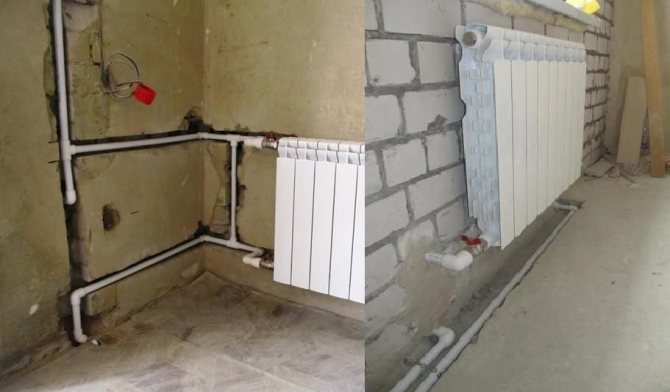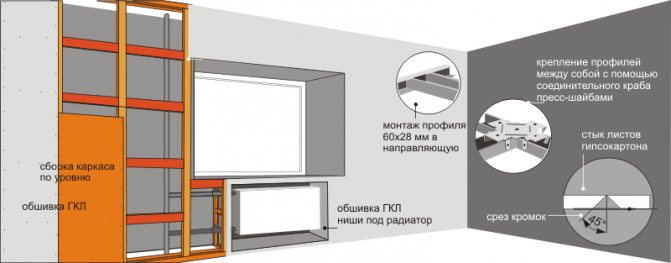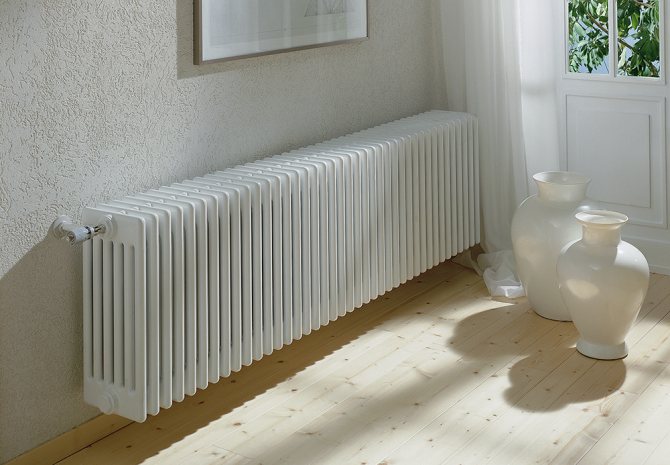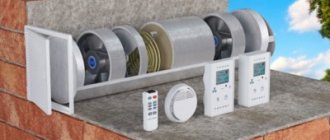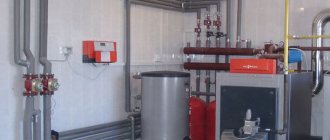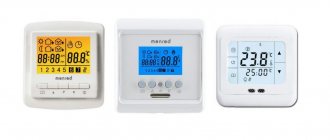We insulate windows and doors
Through the cracks in doors and windows 20-30% of the heat is lost, directly through the glass and the entrance opening up to 15% of the heat is lost. Therefore, first of all, insulate the window and door openings. They must be airtight and close tight. If necessary, use a special putty, insulation and various products. You can use cotton wool or even regular newspapers. For more information on how and how to glue the windows so that they don't blow, read here.
You can additionally hang polyethylene canvases or bath curtains on the windows. Such materials let in sunlight, but do not let cold air from the street. And the sun's rays will fill the apartment with warmth and heat the room.
Heaters as a method of warming a room
Today there is a considerable selection of heating devices, let's look at several types, and compare them with each other in the following parameters:
- principle of operation;
- advantages and disadvantages in use;
- price.
It's cold at home
The most popular and efficient heating devices will be considered, such as:
- convector.
- fan heater or heat gun;
- oil heater.
- Convector.
This device has recently appeared on store shelves, but it is quickly gaining momentum and winning its fans.
Convectors are of several types:
- Aquatic;
- Electrical;
- Gas.
The main principle of heat generation in any of them is the continuous circulation of air masses through the convector body, usually from bottom to top, since cold air is much heavier than warm air.
But still, there are differences between them, everything depends on the room in which they plan to use it, for how long and how often. Let's take a look at the advantages and disadvantages of each one separately.
Advantages of a water convector:
- has a fairly low heating temperature, but at the same time maintains heating at a good level, heats up quickly and can significantly reduce energy costs;
- the weight of the convector is relatively small, which allows it to be attached to walls and plasterboard partitions;
- the convector blocks the penetration of air from the street into the room, if it is fixed under the windows, something like a heat curtain is formed.
Disadvantages:
- The distribution of air flows is uneven, drafts may form;
- constant circulation of dust in the room;
- the water convector does not allow the use of artificial ventilation in the room, since all the heated air initially goes up and, accordingly, it will simply go outside;
- rooms with high ceilings are poorly heated, since all the heated air accumulates at the top.
Electric convector
The advantages of an electric convector:
- silent operation of the device;
- ease of use and installation;
- The efficiency reaches 95%;
- heating speed;
- cost.
Disadvantages:
- The efficiency drops noticeably over time;
- high power consumption;
- cannot heat large premises;
- dries the air.
Advantages of gas convectors:
- safety in use;
- made from environmentally friendly materials.
Disadvantages:
- to install this device, you must invite employees of gas companies.
Prices for convectors range from 2000 rubles. up to 50,000 rubles. The most economical in price are electric convectors, the most expensive are water convectors.
In general, the choice of convectors in stores is very diverse, with the help of them you can heat either a room or the whole house. The choice is always up to the consumer.
- Fan heater or heat gun
This equipment is equipped with a heating element, which is blown by air coming from a fan, due to this, streams of warm air masses are formed.
Fan heaters are of three types: heating elements, spiral and ceramic, but the principle of operation does not change from this.
The clear advantages of these heaters are:
- room warming up speed;
- the temperature can be adjusted with a thermostat;
- low cost.
Home Fan Heater
Disadvantages:
- any of the listed fan heaters will dry the air;
- if various small particles enter the device, an unpleasant odor may be emitted or harmful substances may be released;
- noisy;
- air currents will raise all dust from the surfaces of the room;
- there can be sudden temperature changes between the ceiling and the floor.
On average, the price of heat fans varies from 800 rubles. up to 20,000 rubles.
Thermal fans are suitable for short-term use. This is one of the economical ways to warm a room.
- Oil heater
It is a sealed housing with a heater installed inside and filled with special liquid oil. When the oil is heated, the heater body heats up, and due to self-convection, the air in the room also begins to heat up.
Its undoubted advantages are:
- affordable price;
- long service life;
- economical power consumption;
- does not dry the air;
- safety, as it does not have exposed heating elements.
Disadvantages:
- slow heating of the room;
- massiveness.
The price of an oil heater varies from 1,500 to 12,000 rubles.
Overall a very good value for money.
How to keep warm in a cold apartment
- Warm drinks and food, especially soups and broths, raise your body temperature;
- In order to keep warm and not freeze in a cold apartment without heating, it is important to dress correctly. Experts advise using multiple layers of clothing. It is optimal to wear cotton products downwards, and on top - from fleece or wool or from artificial materials. Loose pants and a sweatshirt or a thick and long robe work well;
- Be sure to wear warm socks and slippers. If your feet are constantly freezing, use warm black tights, tights, leggings or leggings. Slip the garments under your main clothing. They are able to keep warm;
- Go in for sports. Twenty minutes of vigorous exercise will improve circulation, keep you warm and keep you warm after exercise. In addition, sports activities will strengthen the immune system and make the body more adapted to the cold;
- You can warm up cold shoes, bed and even your body with a hair dryer. But do not cover the device, otherwise it may overheat and catch fire!
- Sitting in an armchair, use warm blankets or a shawl. You can use a special electric blanket for sleeping. It is more efficient and cheaper than the old classic heaters. Such a blanket maintains the desired temperature for the required time;

- The heating pad has been helping to keep warm in cold weather for many years. If you don't have one, use a plastic bottle filled with hot water. However, it will cool down quickly and you will have to change the contents;
- Alternatively, take a sleeping bag. It warms up perfectly, especially products designed for zero temperature. You can wrap yourself in a bag like in a blanket, or sleep like under a blanket;
- Take a second blanket for sleeping, a warm blanket or blanket and sleep in socks. Wear thin cotton socks to help your skin breathe and your feet don't sweat or freeze even more;
- Take a hot bath or shower, or occasionally use hot foot and hand baths. After water treatments, apply lotion or oil to the skin. Such formulations act as another layer of thin clothing.
If you have intermittent heating shutdowns or small children live who cannot get cold, it is better to buy at least one heater. Choose oil radiators, wall or floor heating convectors. If you are purchasing only one product, it is better to choose a portable or mobile model for easy movement from room to room.
With the help of heaters, you will quickly warm up. But be prepared that they consume a lot of electricity and dry the air. If in an apartment with the heating on the batteries do not heat well, be sure to contact the management company! And when the heating season begins and ends, as well as what to do if there is no heating in the apartment, read the link https://vsepodomu.ru/zhkh/otopitelnyj-sezon/#i-3.
wikiHow works like a wiki, which means that many of our articles are written by multiple authors. To create this article, 116 people, some anonymous, worked to edit and improve it over time.
Number of sources used in this article: 10. You will find a list of them at the bottom of the page.
Perhaps you are a poor student or just frugal. What if your home's heating system still hasn't been repaired? Maybe you live in an old, drafty house? Perhaps you want to reduce your CO2 emissions. Regardless of the reason, you need to bask in cold weather. Here are some helpful tips.
The main types of radiators for central heating, their disadvantages and advantages
Cast iron radiators.
The most widespread type of radiators for several decades. Only the appearance has changed significantly - there are models that are real design samples (their cost is corresponding). They are good for use in residential and industrial multi-storey buildings.
Benefits:
- high heat transfer;
- strength and durability;
- unpretentiousness and endurance;
- large flow area, allowing to maintain the throughput even with the accumulation of deposits.
Disadvantages:
- the need for flushing 2-3 times a year;
- vulnerability to strong mechanical stress (the battery may crack);
- high price.
Aluminum radiators.
It is currently very popular with Russians. They consist of sections, the number of which depends on the area of the heated room. It is this type that is characterized by the greatest degree of heating, achieved due to the high thermal conductivity of the metal itself and an increase in the area of thermal conductivity, thanks to the developed finning system. By design, the models are sectional and solid.
For centralized heating systems, aluminum radiators are not recommended for use. Since in the presence of oxygen in the coolant, this metal is oxidized, and "airing" of the sections occurs due to the release of hydrogen. To avoid this, the device requires regular maintenance and evacuation.
Benefits:
- ease;
- external attractiveness;
- strength and reliability;
- excellent heat dissipation.
Disadvantages:
- susceptibility to corrosion;
- the need for regular bleeding of air from the radiator through the air vent valve;
- deformation of aluminum during water hammer;
- solid particles present in the coolants contribute to the destruction of the walls of the device from the inside, which reduces the service life of the device (this problem is solved by equipping the radiator with mud collectors and additional filters that require regular cleaning);
- when connecting aluminum pipes with copper, rapid destruction of aluminum.
Steel radiators.
A common view in low-rise private construction. Not the best option for district heating because:
- usually the working pressure in the heating system exceeds the permissible;
- with water hammer, the service life is significantly reduced and is only a few months.
Benefits:
- attractive design;
- occupation of a small place in the room.
Disadvantages:
- susceptibility to corrosion;
- the average service life, subject to the operating rules, is no more than 7 years.
Bimetallic radiators.
Combines the advantages of the two previous types of radiators, due to a special design - an aluminum shell and a steel core. They are used for any type of heating, but especially from the good side, they have proven themselves in high-rise buildings with central heating.
Benefits:
- the ability to withstand significant loads and hydraulic shocks, strength;
- high heat transfer;
- light weight and well thought-out shape, which contributes to efficient heating of the room.
Disadvantages:
- high price due to the complexity of the design.
findings
So, it is not possible to give an unambiguous answer to the question of which heating radiators are better for central heating, since each specific situation is individual and the choice depends on the characteristics of the living conditions and the price range. But in general, the opinions of experts boil down to the following:
- Due to the unpredictability of central heating, they are considered the best at the moment, combining mechanical strength, high heat transfer and aesthetic appearance. The main disadvantage is the high cost.
- Cast iron radiators are also noteworthy, but require more maintenance.
- It is better to refuse steel and aluminum radiators in houses with central heating, due to the peculiarities of these metals - susceptibility to corrosion, interaction with other metals, etc.
The purpose of heating radiators is to transfer heat from their surface, heated from the inside by a hot coolant. It will simply be unprofitable to squander the paid kilocalories to heat a cold wall located behind the battery, or install a decorative screen-casing that does not let warm air from the radiator pass through.
Thermal insulation of heating batteries provides:
- wall shielding to retain heat transmitted by radiation from the surface of the radiator,
- reliable protection against possible burns and bruises on the hot surface of the radiator, but does not interfere with the movement of thermal convective flows to heat the home.
Hang up blackout curtains: open them in the morning and close them at dusk
With the onset of winter, thin curtains on the windows should be replaced with blackout curtains and closed as soon as it gets dark outside. Thick curtains will act as a thermal insulator and protect the house from cold air currents. This is especially true if the windows are blown out (unfortunately, not only old wooden windows, but also some modern plastic ones).
During the day, the curtains need to be opened, and the wider the better. Sunlight and heat will enter the room through the window. It is clear that the temperature will increase by a maximum of 1–2 degrees, but it will still be much more comfortable to be indoors at lunchtime.
Stylish blackout curtains of dark gray or chocolate color from the Mebelion home goods store will help keep warm and create coziness in the apartment.
Curtain Primavelle in Mebelion From 2 800 rub. +7
Curtain Mona Liza in Mebelion From 3 250 rub. +7
Infrared heaters
These devices will be described in a separate chapter, as they are very different from previous heating devices. They do not heat the air in the room at all and do not interact with it in any way, but heat objects, including the floor and walls. Due to the fact that the wavelength of infrared radiation is quite long, they can warm up large rooms. Thanks to the heating of ceilings and walls, you can both warm the room and keep warm for some time without using a heater.
Infrared heater
The advantages of such a heater are as follows:
- instant heating;
- does not dry the air;
- do not burn oxygen;
- durable;
- silent;
- create the effect of "warm floors";
- compatible with any ventilation systems.
Disadvantages:
- heated pointwise;
- the problem of finding people under infrared rays;
- high price.
Such heaters are used more for small office or office space, less often for home. The cost of high-quality infrared heaters is quite high, and several copies are needed to heat large rooms.
The price varies from 2,000 to 18,000 rubles.
Buy an electric blanket or sheet
Lie in a cold bed? Even thinking about it is unpleasant. It happens that you cover yourself with three blankets, but still you cannot keep warm and fall asleep. To sleep only in a warm bed, use an electric sheet or blanket. They are equipped with special heating elements and have several temperature regimes. Turn on the sheet 15-20 minutes before bed and go about your business. Come back - and the bed is already dry and warm.
Electric sheets are completely safe, because they are equipped with an automatic shutdown system, while you choose the time yourself (usually the sheet needs to be turned off after three to seven hours of operation).
The power of the sheet is 40–100 watts, but a lot depends on the model and size of the device. And, by the way, the electric sheet can be washed (the cable used to heat the sheet is removable).
Dependence of heat output on the type of connection
The characteristics of the battery depend not only on the temperature regime of the coolant and structural material, but also on the type of connection of the device to the heating system:
- direct one-way connection - the most efficient, reference connection type;
- diagonal connection - used to reduce heat loss if the battery has more than 12 sections;
- bottom connection, in which up to 10% of energy is lost - used to connect to the heating system in the floor screed;
- one-pipe connection is the most unprofitable, heat losses fluctuate within 30-45%.
Scatter blankets around the apartment
The more warm blankets in your apartment, the better. They can be found on every sofa and every chair. They began to freeze - threw a blanket over their shoulders, warmed up - put the blanket aside. Plus, cute blankets are stylish interior items.
By the way, blankets with sleeves are now popular: it is very convenient to read a book in them, work at a computer or drink hot tea.
You can find a warm, beautiful and cozy blanket made of natural wool in the Perina Peroni bedding salon.
Plaid "Paters" in "Perina Peroni" From 5 870 rubles. +7
Plaid "Paters" in "Perina Peroni" From 3 650 rubles. +7
Alternative ways to heat rooms
Along with the situations under consideration, the question often arises - what to do if there is no heating in one room? The best way to solve this problem is to install lines and radiators. If this is not possible, alternative ways of increasing the room temperature should be considered.
Infrared room heating
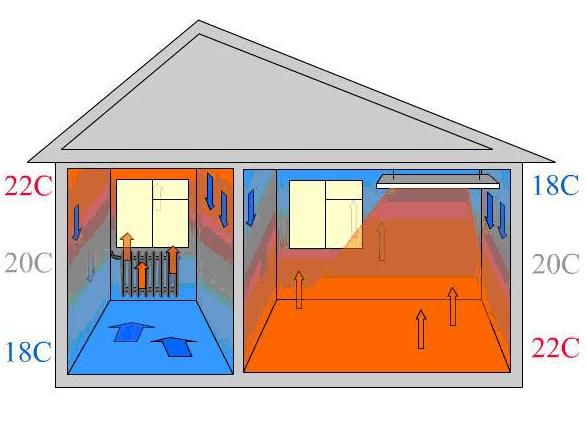

IR heating of the room
Currently, this is one of the most acceptable options for solving the issue of how to heat a room without heating. For this, you can use several types of heating systems: IR heaters, underfloor heating.
However, it should be borne in mind that the principle of exposure to infrared radiation is not in the convection of air currents, as occurs when a room is heated by a central heating radiator, but in the effect on the surface of objects. As a result, they heat up, which raises the room temperature.
Features of IR heating:
- Relatively high energy consumption compared to water heating;
- Low inertia. The heating of the room occurs relatively quickly, as well as the change in the power of the IR study;
- Possibility of using as an additional heating system.
The best arrangement is the installation of infrared film. To heat a room without heating, this is done in two ways - organizing a warm floor or installing it on the walls in the upper part of the room.
When calculating IR heating for a room, it must be borne in mind that heating elements cannot be covered with furniture or other interior items. This could lead to damage.
Stock up on heating pads
Of course, an electric sheet is the result of technical progress, but hot water in a rubber heating pad or a simple plastic bottle was, is and will be one of the simplest and most effective means for heating a bed or body. It was not for nothing that servants put copper heating pads in their masters' beds several centuries ago. And now the rules of the game have not changed: put a heating pad in your bed before going to bed - and enjoy the warmth.
It is worth noting that there are special heating pads on sale that can be placed in the microwave. Heat it up for one minute - and you can use it. In addition, there is a salt heating pad: it heats up due to salt crystallization. The temperature of such a heating pad reaches 52 degrees Celsius.
Screens on the radiator
Strange as it may sound for most of today's consumers of central heating, but originally cast-iron radiators were covered with decorative covers in order to protect (mainly children and the elderly) from bruises and burns on the surface of the heating sections of the radiator heated to a high temperature. There was enough heat for everyone, the central heating coped with the heating of a few apartments equipped with heating devices. At the same time, incorrectly executed deaf protective boxes - the screens did not allow the lion's share of the heat from the hot radiator to pass through. But many years of practice have taught how, with the help of screens, even intensify convective air flows to heat a home.
To prevent the screen from interfering with the spread of radiant energy from the radiator through its surface, it is recommended to cover no more than 50% of the area of the front pattern of the screen or casing. This is achieved by perforation or a patterned decorative pattern. The best heat transfer for the room will be provided by metal screens, the design of which is so simple that it does not require professional installation skills. They are either hung on the battery, or attached to the wall in the simplest ways.
Experts have developed recommendations for the most favorable placement of heating radiators and screens for them. According to the developed rules, the optimal height from the lower edge of the radiator section to the floor is 10 cm. Therefore, the screen should not be installed close to the floor, and also raised above the floor to the same height of 10 cm, so as not to impede the movement of heated air upwards.
It is important!
If the radiator is placed under a window, it is recommended to make holes in the window sill to intensify the air flow.
The efficiency of using the screens depending on the position of the battery and the screen is shown in the figure.
For heating a room, it is important how fast heat is supplied to the room. Since in traditional water heating systems radiators are responsible for heat transfer, the indoor climate depends on how effectively they cope with the task. The efficiency of heat transfer is characterized by such a parameter as heat transfer or heat output. In the case of a radiator, it shows how much heat per hour a given device can transfer to air under certain conditions. Conditions mean the set temperature of the coolant, the speed of its movement and a certain type of connection. At factories, the heat transfer of heating devices is determined during testing at stands, then it is averaged and entered into the product passport.
How efficiently the heating device will give off heat depends on many factors. This is the material from which it is made, and its shape, and how the coolant moves inside and what the heat transfer surface is. We will tell you a little more about all these factors below.
Brew warming teas
What does "warming" mean? “Any hot tea warms you up,” you say. Yes, you can't argue with that, but still, winter teas must necessarily contain special ingredients: ginger, cinnamon, lemon, honey, cloves, pepper. For example, here's a recipe for apple and lime ginger tea:
- 0.5 l of water;
- 3-4 cm of ginger root;
- a pinch of cinnamon;
- 1 tsp green tea;
- 3 tsp flower honey;
- cloves;
- 1/2 lemon;
- slices of green apple and lime.
- peel and chop the ginger root;
- pour water into a saucepan, add ginger, cinnamon, cloves;
- bring to a boil and cook for 10 minutes;
- put honey and lemon (squeeze the juice from the lemon and throw the leftovers into the saucepan);
- cook for another 5 minutes;
- brew green tea in a teapot, strain hot broth into it;
- pour into circles, adding slices of green apple and lime. Done!
Hug!
Keep warm with your loved ones and be happy. And then no cold is terrible!
- Embrace! Surely! And this, I want to assure you, is not only a unique remedy for all seasons, but also a panacea for all experiences.
If you feel annoyed, go hug your loved ones! Or, for example, you are on a diet, and someone cooked baked goods, and then opened the oven to keep warm. Ignore the kitchen and go to your bedroom or nursery for a dose of hugs. Believe me, it's better than cookies! Winter is the time to give and receive warmth!
